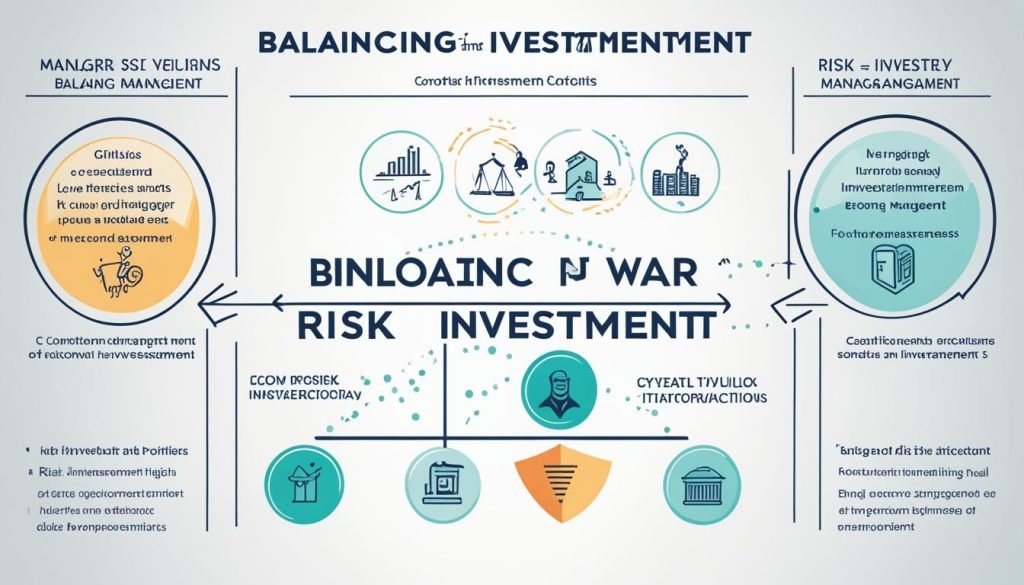Starting to learn about investment portfolio management can lead to long-term financial success. We’ll cover the basics of managing a portfolio well. This includes how to spread out your investments and reduce risks. We’ll also look into making a strong investment plan and how experts manage investments.
Key Takeaways:
- Understanding investment portfolio management is essential for long-term financial success.
- Asset allocation plays a crucial role in optimizing portfolio performance.
- Risk diversification helps mitigate potential losses and ensures a balanced portfolio.
- Crafting an investment strategy is vital and requires careful consideration of goals, risk tolerance, and market conditions.
- Portfolio managers utilize various techniques to actively manage and monitor investments.
The Foundations of Effective Portfolio Management
Building a strong portfolio starts with understanding asset allocation and diversification. Asset allocation means spreading your investments across different types to balance risk and reward. Diversification is key, spreading your money across various assets to lower risk. This way, if one investment does poorly, it won’t hurt your whole portfolio too much.
Knowing the market is vital for managing your portfolio. Keeping up with trends, economic news, and global events helps you make smarter choices. By watching the market closely, you can change your portfolio to fit new conditions.
For top portfolio performance, you need to keep checking and tweaking your plan. Look at how your portfolio is doing against your goals. If it’s off track, you might need to rebalance your investments or add new ones that fit your goals.
A great portfolio manager knows how to balance risk and reward, even when the market is shaky. They manage your investments to aim for steady gains, despite market ups and downs.
Crafting a Robust Investment Strategy
Building a successful investment portfolio starts with a strong strategy. You need to think about your goals and how much risk you can handle. Deciding on the right mix of investments and how to manage them is key.
Investment objectives guide your investment path. They tell you what you want to achieve, like growing your money, earning income, or keeping it safe. Knowing your goals helps you pick the right investments.
Understanding your risk tolerance is also vital. It’s about how well you can handle market ups and downs and possible losses. This helps you find the right balance between risk and reward.
Asset allocation means spreading your investments across different types, like stocks, bonds, and cash. This helps lower risk and can increase your potential gains. The right mix depends on your goals, how much risk you can take, and when you plan to need the money.
There are two main ways to manage your investments: active management and passive management . Active management means picking and managing investments to beat the market. It takes a lot of work and research. Passive management is simpler, aiming to match a market index through index funds or ETFs.
“Investing should be more like watching paint dry or watching grass grow. If you want excitement, take $800 and go to Las Vegas.” – Paul Samuelson
Portfolio managers are key in helping investors make and manage their investment choices. They use their market knowledge to guide investors. This can help investors meet their goals and manage risk better.
Benefits of Active and Passive Management
Both active and passive management have their advantages. Here’s a look at what each offers:
| Active Management | Passive Management |
|---|---|
| Allows for potential outperformance | Low cost |
| Flexibility to adapt to market conditions | Broad market exposure |
| Opportunity for active decision-making | Market returns with reduced risk |
| Access to specialized investment strategies | Diversification across multiple securities |
Choosing between active and passive management depends on your goals, risk level, and what you prefer. Some like the idea of beating the market actively, while others prefer a simpler, cheaper approach. It’s important to weigh the pros and cons of each to see which fits your needs.
A solid investment strategy is key to doing well over time. It should match your goals, risk comfort, and how you want to manage your investments. With careful planning and the help of portfolio managers, you can invest with confidence.
Risk Management Techniques in Portfolio Management
Managing risk well is key to a successful portfolio. By using smart strategies, investors can protect their money from big losses. We’ll look at ways to keep and improve portfolios safely.
Diversification: Spreading Out Risk
Diversification is a top strategy for managing risk. It means putting money in different types of assets, sectors, and places. This way, one bad investment won’t bring down the whole portfolio. It lowers the risk of big losses.
For instance, instead of just tech stocks, an investor might put money in healthcare, finance, and consumer goods too. This spreads out the risk, as different areas do well in different times.
Risk Tolerance: Understanding Your Limits
Risk tolerance is how much ups and downs in investment values you can handle. It’s important to know your risk level before investing. If you’re okay with more risk, you might go for investments that could bring in more money but also could lose more.
On the other hand, if you’re cautious, you might choose safer investments for lower returns but less risk. Matching your investments with your risk tolerance helps manage risk and keeps you comfortable with your choices.
Stop-Loss Orders: Limiting Downside Risk
Stop-loss orders are a useful tool for managing risk. They set a price to sell a security if it hits or goes below that price. This way, investors can sell before a security’s value drops more, limiting losses.
For example, buying a stock at $100 and setting a stop-loss at $90 means selling it if it hits $90. This limits the loss and helps the investor get out before big drops.
Using diversification, knowing your risk tolerance, and stop-loss orders can help investors keep their portfolios safe from big losses. These strategies help investors deal with market ups and downs better. They keep a balanced approach to risk, improving their portfolio’s long-term success.
| Risk Management Techniques | Description |
|---|---|
| Diversification | Spreading investments across different asset classes, industries, and regions. |
| Risk Tolerance | Assessing and understanding one’s willingness and ability to endure investment volatility. |
| Stop-Loss Orders | Placing predetermined sell orders to limit downside risk and protect against losses. |

Measuring and Adjusting Portfolio Performance
Checking and tweaking your portfolio’s performance is key to long-term investment wins. It’s important to look at how each asset and the whole portfolio are doing. By keeping an eye on things like return on investment, how volatile it is, and risk-adjusted returns, you can see if your investment plan is working.
Rebalancing is also a big part of managing your portfolio. It means adjusting your asset mix to keep the risk and return you want. By doing this, you can cash in on assets that are doing well and put that money into ones that aren’t doing as well. This keeps your portfolio spread out and in line with your long-term goals.
When deciding to rebalance, think about your risk tolerance. This is how much risk you’re okay with taking to get higher returns. If you’re okay with more risk, you might want a portfolio that’s more aggressive. If you prefer less risk, you might want a more conservative mix. Knowing your risk tolerance helps you make smart choices about your portfolio.
Managing your portfolio well means always learning and adapting. The markets change, and so should your investment strategies. By staying up-to-date, making choices based on data, and regularly checking and adjusting your portfolio, you can confidently move through the changing investment world.
FAQ
What is asset allocation?
Why is diversification important in portfolio management?
What role do portfolio managers play in managing investments?
What is the difference between active and passive portfolio management?
How does risk management play a role in portfolio management?
Why is portfolio rebalancing important?
Source Links
- https://scrab.com/blog/mastering-the-art-of-portfolio-management-strategies-for-success-in-modern-investing
- https://www.linkedin.com/pulse/mastering-portfolio-management-strategies-optimizing-investment
- https://www.linkedin.com/pulse/mastering-portfolio-management-strategies-deep-dive-kakarlapudi-dub2c



